

Andrew Maclean
2025 Mahindra XUV 3X0 vs Chery Tiggo 4: Spec battle
1 Month Ago
Toyota's teeniest SUV is a fun, efficient way to get around in top-spec hybrid FWD guise. Arguably, it's a better buy than the hatchback too.

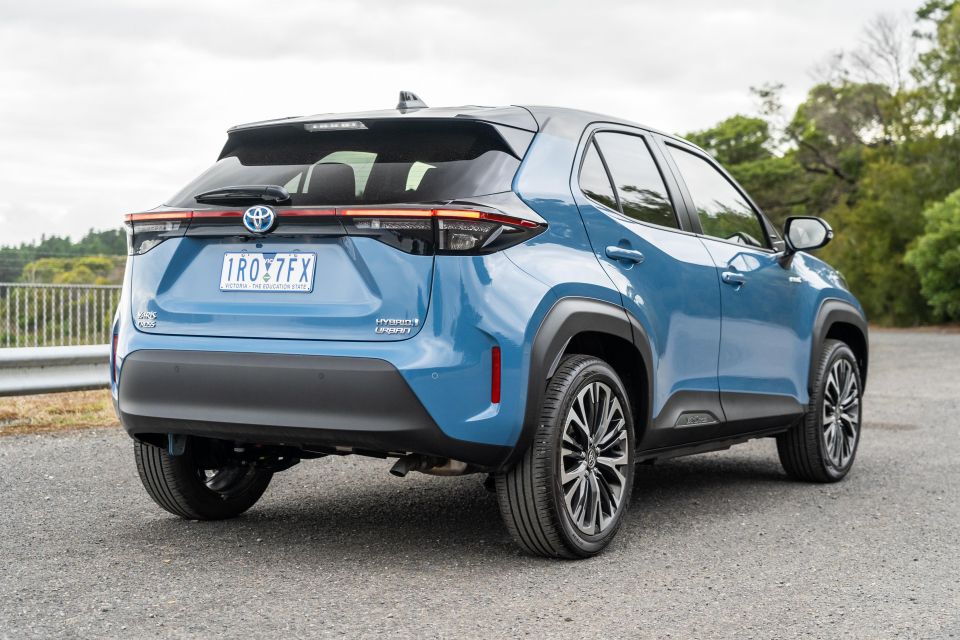

Marketplace Editor
New from
$26,990
excl. on-roads

Marketplace Editor
New from
$26,990
excl. on-roads


Marketplace Editor
New from
$26,990
excl. on-roads

Marketplace Editor
New from
$26,990
excl. on-roads
Quickly see how this car stacks up against its competition. Select any benchmark to see more details.
Where expert car reviews meet expert car buying – CarExpert gives you trusted advice, personalised service and real savings on your next new car.
The Toyota Yaris Cross is a fashionably late entrant into the booming city crossover segment.
Small and Light SUV sales in Australia continue to grow at huge rates, and it’s no surprise the world’s biggest car brand is keen to cash in.
Within a couple of months on sale in Australia the Yaris Cross has quickly asserted itself as a monthly sales favourite, placing second behind the ever-popular Mazda CX-3 over the last three months. No doubt Toyota wants to be an even greater presence in the segment given the Mazda outsells the Toyota by nearly 3:1.
Here on test we have the 2021 Toyota Yaris Cross Urban Hybrid FWD, the highest trim level fitted with the front-wheel drive petrol-electric hybrid drivetrain.
A non-hybrid petrol version and an all-wheel drive hybrid are also available – Curt Dupriez recently tested the latter for the local media launch.
So, is Toyota’s first effort at a modern light SUV worth a look? And is the hybrid the way to go?

The Toyota Yaris Cross can be had from $26,990 before on-road costs as a front-drive petrol-only GX, though the Urban Hybrid FWD we have on test retails for $34,990 before on-roads in Australia.
While the base trim is far from the most affordable in class, the Urban Hybrid is fairly in line with rival models such as the Mazda CX-3 Akari FWD (from $34,190) and the Volkswagen T-Cross 85TSI Style ($33,490 drive-away).
Other competitors include the Ford Puma ST-Line V (from $35,540) and the Nissan Juke Ti (from $36,490).
Compared to the Yaris hatch on which it’s based, the Yaris Cross commands a near $3000 premium.
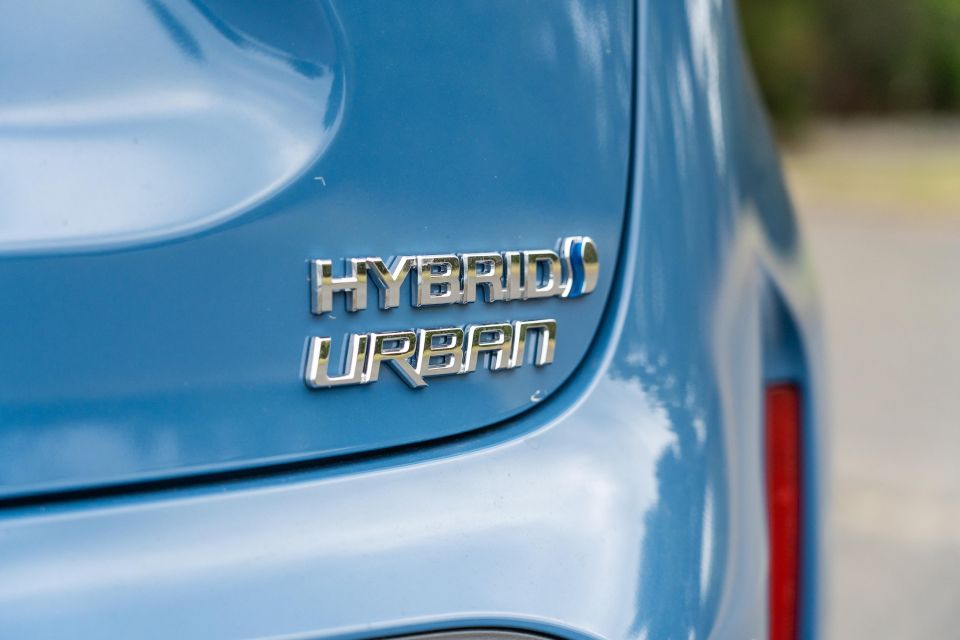
Having hybrid power is a unique selling point, with no other rival in Australia offering an equivalent drivetrain focused on reducing fuel use and emissions to quite the same extent.
The Mineral Blue premium paint with contrasting black roof adds another $950, otherwise there’s no other factory options available.
So, as tested the vehicle you’re looking at here is $35,940 before on-road costs, which works out to just over $40,000 drive-away.
MORE: 2021 Toyota Yaris Cross price and specs

The flagship Urban grade gets the following exclusive appointments over lower grades:
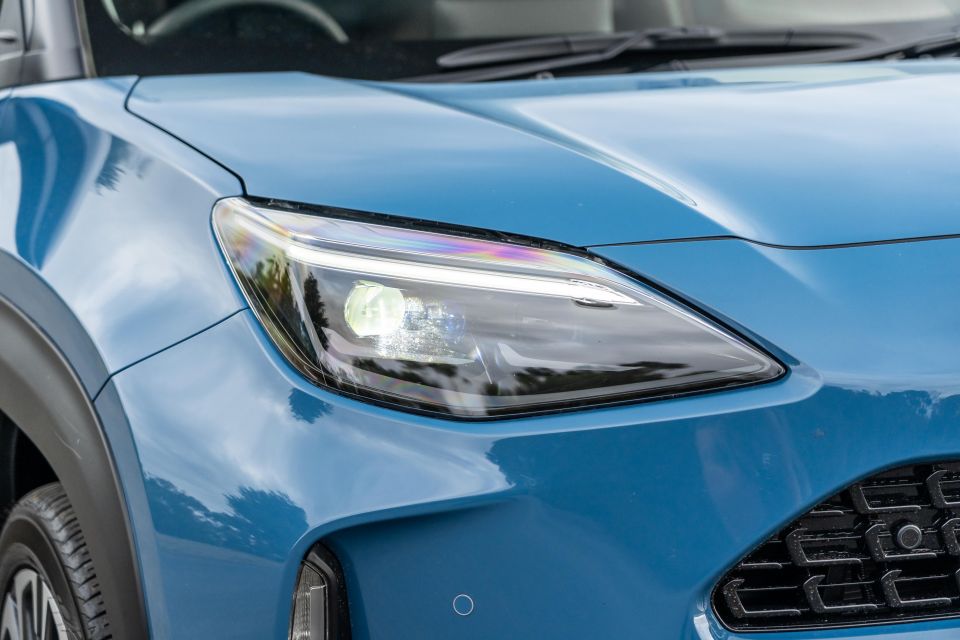
Equipment carried over from lower trim levels includes:
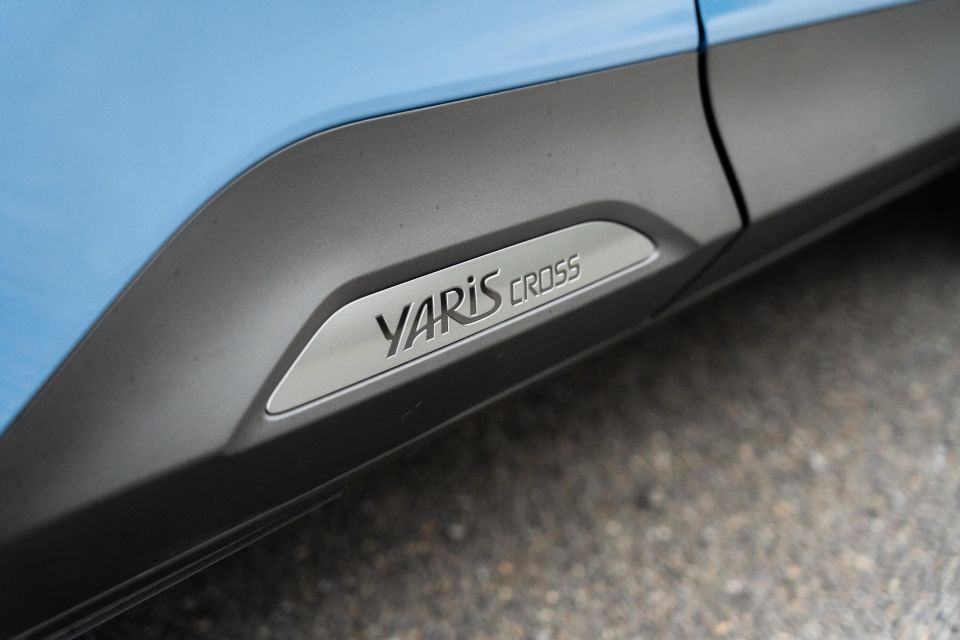
The Yaris Cross comes pretty well kitted out in Urban guise, covering most bases in terms of technology, safety, and convenience items.
Dual-zone climate control and rear air vents would be nice – but you’d be hard-pressed to find a Light SUV competitor fitted with the latter – and some may desire a full leather-accented trim option for the upholstery.
Something I found interesting is that Australian-market Yaris Cross models essentially lift the instrument cluster out of the Yaris hatch with its LCD gear and speed displays, flanking a TFT driver’s information display. A quick look at the European press kit shows the launch version in Europe gets a more sophisticated unit from high-spec versions of the Corolla.
All of these are things you can live without, but for those wanting some of those higher end features you may be better off looking into a vehicle from the class above.

The Yaris Cross is yet to be tested by ANCAP or Euro NCAP.
However, the related Yaris hatchback achieved a five-star safety rating from both ANCAP and Euro NCAP against the latest, most stringent 2020 testing criteria.
All version of the Yaris Cross come equipped with eight airbags (including a front-centre airbag), low- and high-speed AEB with pedestrian and cyclist detection, junction and front cross-traffic AEB, lane-keep assist with lane centring, speed sign recognition, auto high-beam and all-speed adaptive cruise control.
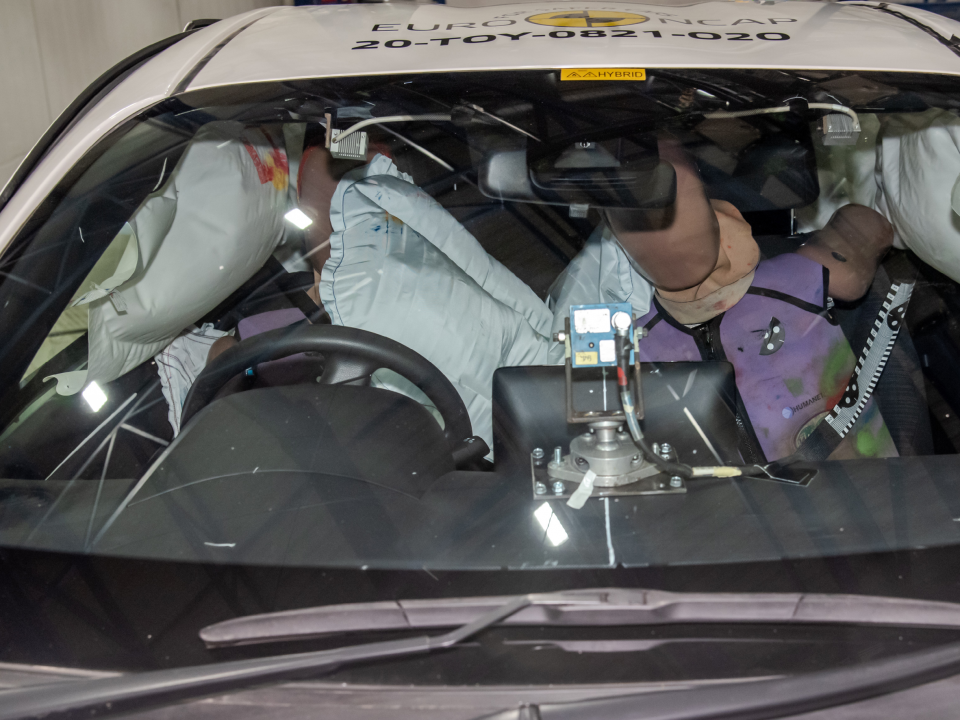
GXL and Urban models step it up with blind-spot monitoring and rear cross-traffic alert. The latter also gets a swish 360-degree camera system.
Toyota should be commended for including such a high level of active safety specification as standard, as it has done with all of its recent releases.
Given the numerous similarities between the Yaris Cross and its hatchback sibling, we’d expect a five-star result to be announced at some point.
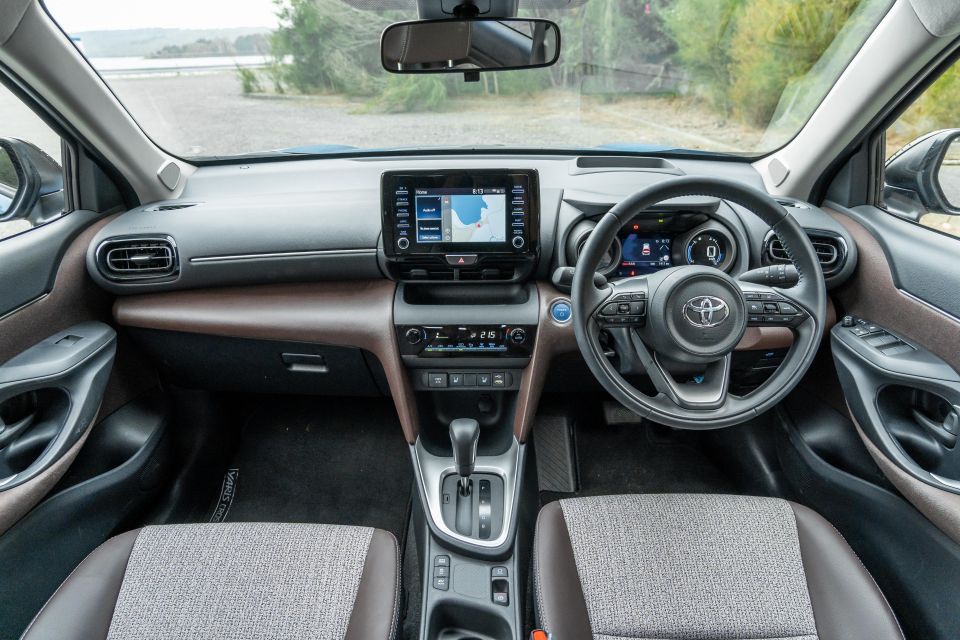
If you’ve spent any time inside the new Yaris (like I have), the Yaris Cross’ cabin will be familiar fare.
The overall design, switchgear, instruments and controls are pretty much all the same, with the main difference being the colour and trims used.
In the Urban grade, you get an interesting black and brown interior, featuring brown leatherette seat bolsters and a tweed fabric-look seat inserts. It won’t be for everyone, but I like the fact Toyota is offering something different and visually interesting.
Toyota’s reputation for solid build quality rings true here, with everything feeling really well screwed together and built to stand the test of time. However, prodding and pressing some of the plastics and trims reminds you this is based on a light hatch built to a price – a C-HR has a much nicer cabin in terms of materials and tactility.
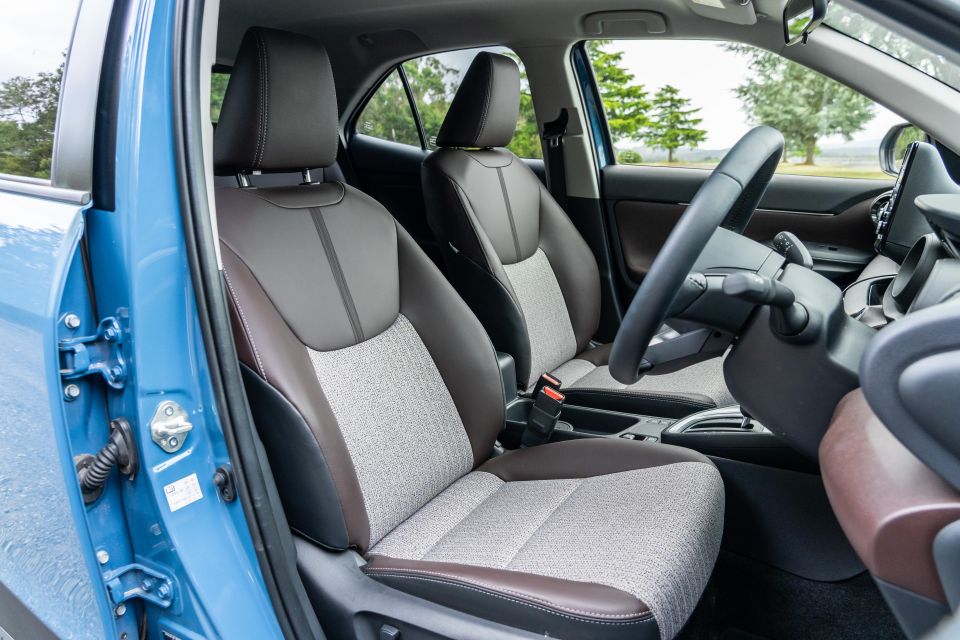
We’re big fans of the steering wheel, which feels great in the hand, looks a touch sporty, and has all the requisite buttons and controls.
The driver’s seat is electrically adjusted and also features heating, and both the seat and steering wheel offer good levels of adjustment so most people should be able to find a comfortable driving position.
Speaking of the pilot’s pew, it’s comfortable enough and offers good support. It’s no sports seat in terms of bolstering – which some might see as a good thing – but for the vehicle’s intended purpose the front chairs are good ones.
There’s decent storage up front, too. A shelf below the infotainment display will hold phones and wallets, a larger cubby below the HVAC controls will do the same and more, plus there’s cupholders in the centre and door bins large enough to swallow the average bottle.
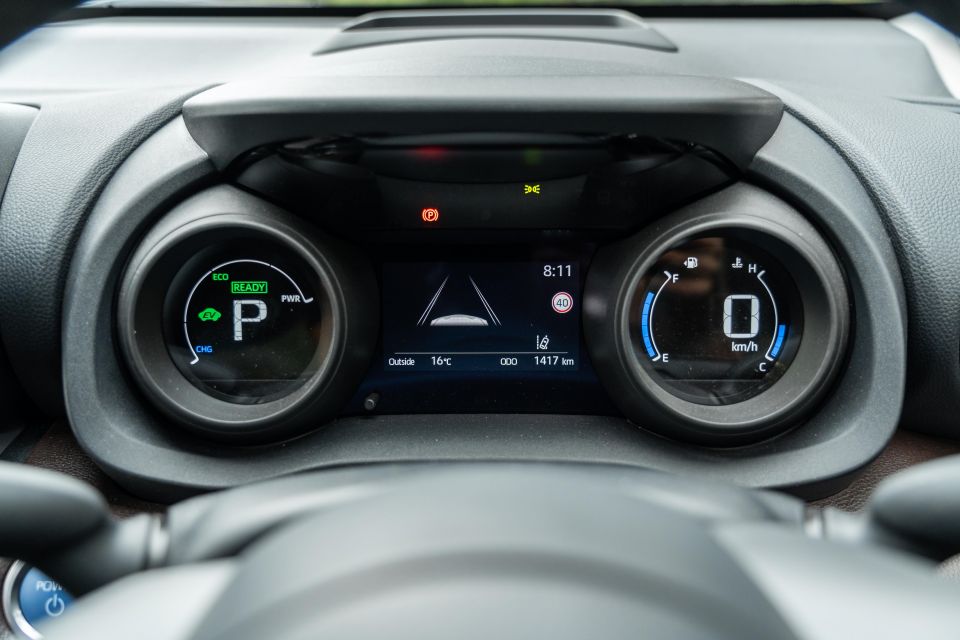
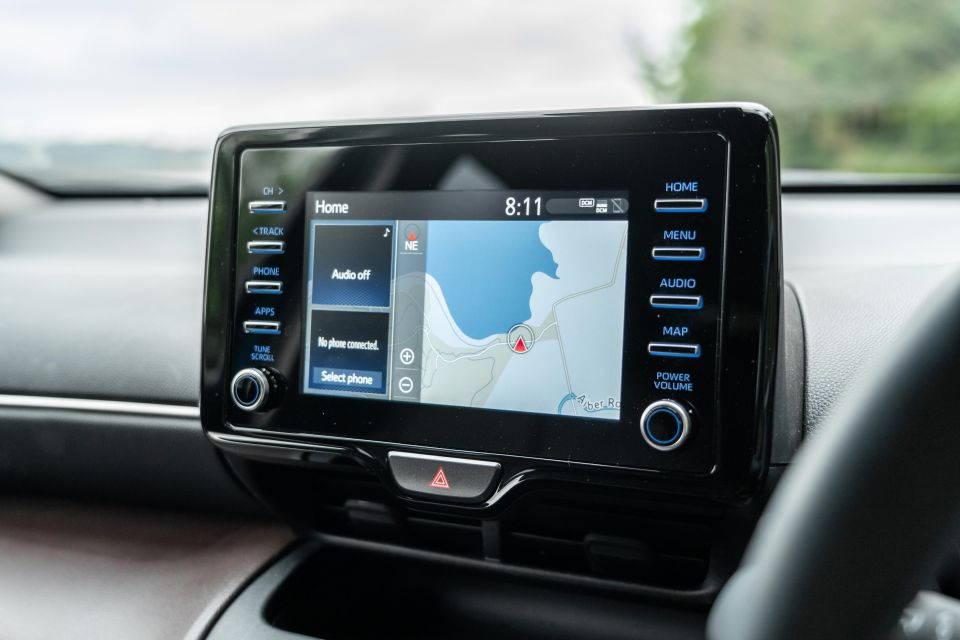
Toyota’s current infotainment setup cops a lot of flack for being basic and looking dated, but it’s well featured with native satellite navigation and DAB+ radio, as well as wired Apple CarPlay and Android Auto.
The larger 8.0-inch screen from other Toyota models would be a nice touch, though, and it’s of a lower display resolution than some of the screens you’ll find on some rivals. Nothing major, but some areas for improvement.
While we’re on the topic of small gripes, there’s no centre armrest between the front seats, which looks and feels a bit cheap. Instead, there’s just another storage cubby that’s good for coins, keys, or maybe a mount for an armrest.
Toyota has also chosen to forego padded textile door inserts and instead put in a cardboard roofliner-like material. It looks interesting, but doesn’t feel particularly plush.

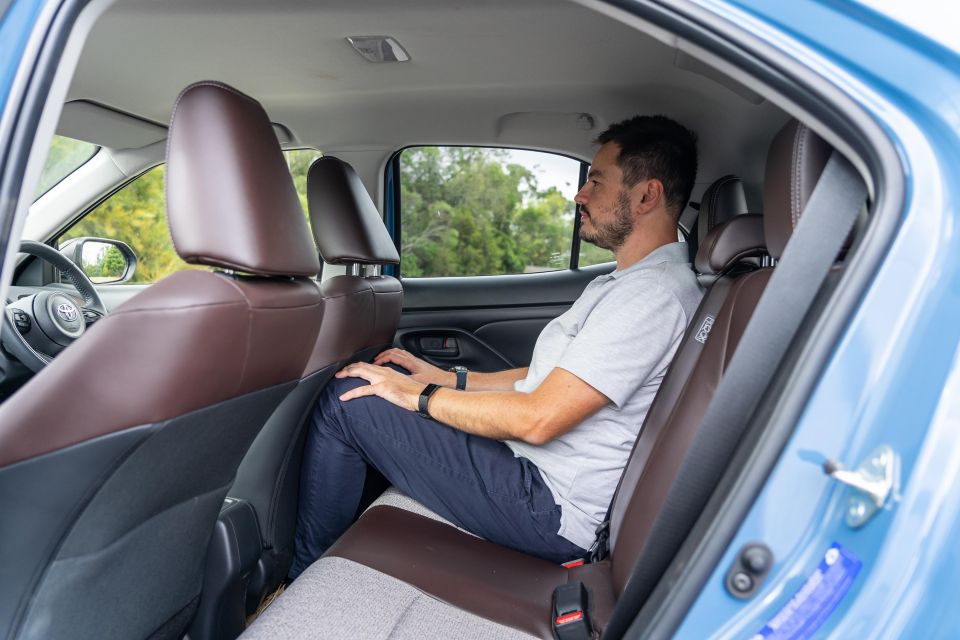
Being a light crossover, rear passenger accommodation isn’t the main focus. But we can report the Yaris Cross has adequate, not amazing, second-row accommodation.
If you’re any taller than six-foot, leg- and knee room will be tight-ish though headroom is good.
There’s ISOFIX child seat mounts on the outboard positions, and top-tether points for all three rear positions. However, there’s no air vents power outlets or fold-down centre armrest.
Rear-seat occupants do get small bottle holders in the doors, but that’s about it.
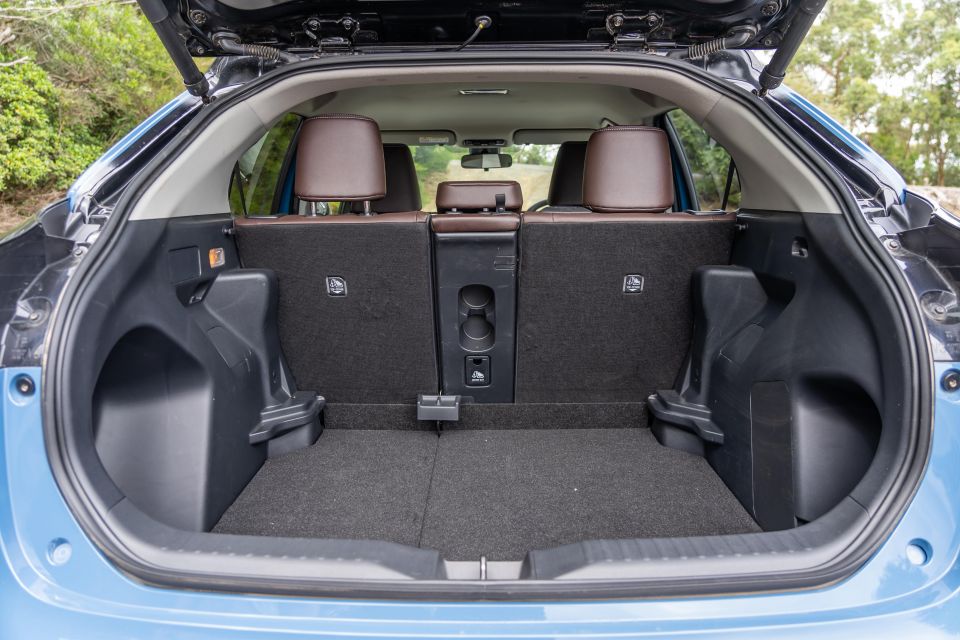
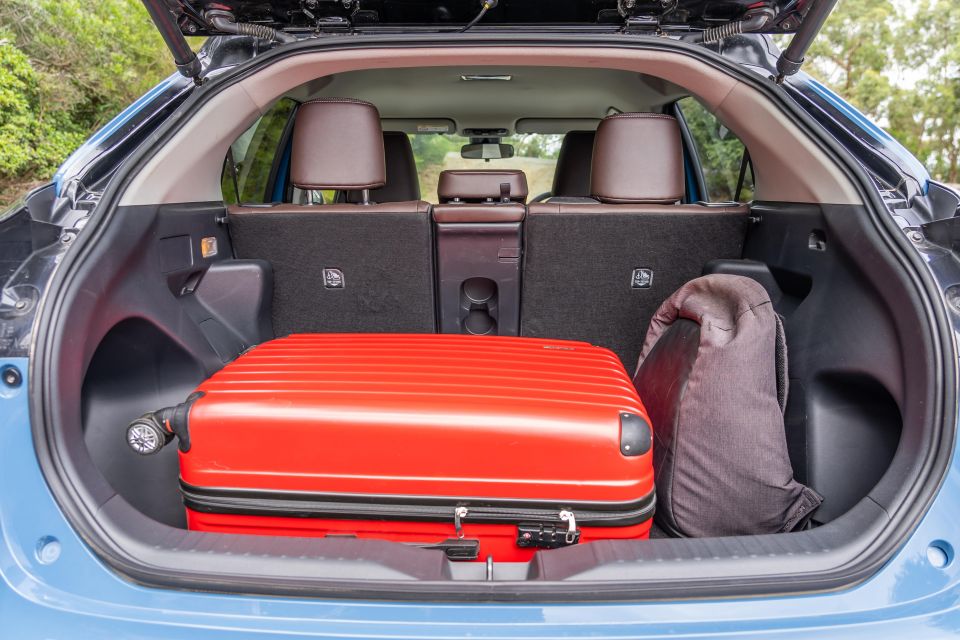
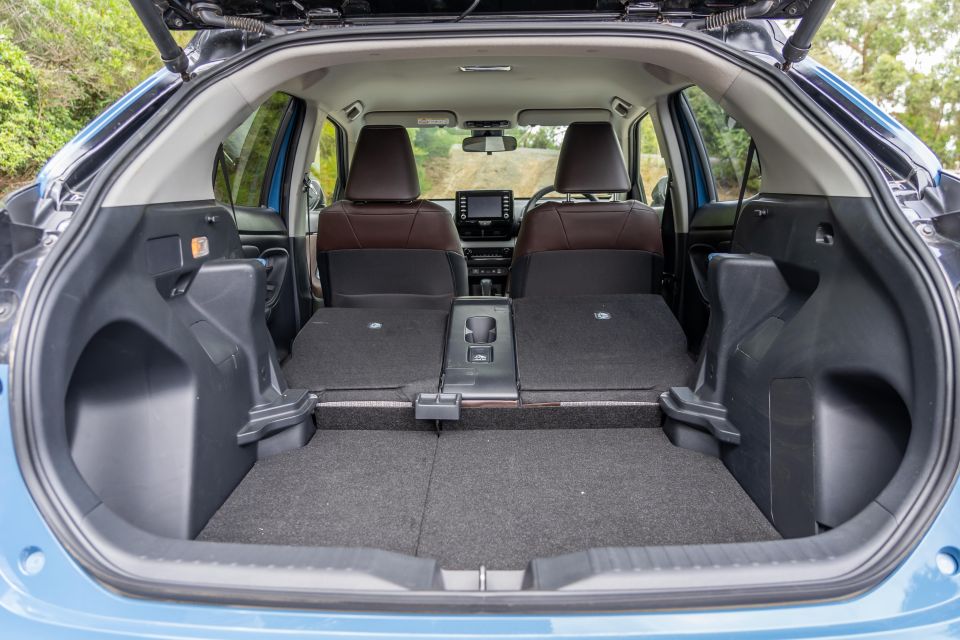
Behind the rear seats is a 390L boot, which is competitive but not standout for the segment. Toyota doesn’t quite a figure with the rear seats folded.
Hybrid AWD models get this figure reduced to 314L due to the extra hardware which raises the boot floor. By comparison, the Mazda CX-3 offers 264L, the Ford Puma has 410L, and the Volkswagen T-Cross offers 385L.
The Yaris Cross also offers 120L more space than the equivalent Yaris hatchback in this specification, which could be a deal-maker if you’re comparing hatch to crossover.
A temporary space-saver spare wheel lives under the boot floor of petrol and hybrid FWD models, though hybrid AWD models get a tyre repair kit.
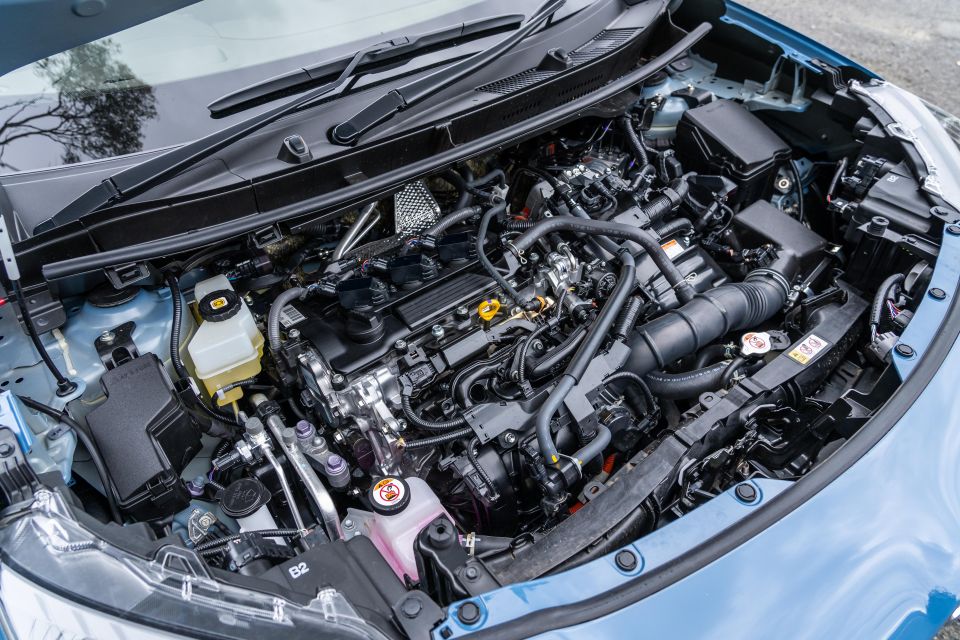
Where expert car reviews meet expert car buying – CarExpert gives you trusted advice, personalised service and real savings on your next new car.
Power in the front-drive Yaris Cross Hybrid comes from a 1.5-litre naturally-aspirated three-cylinder petrol engine running the more efficient Atkinson cycle, hooked up to an electric motor and CVT automatic.
System power is quoted at 85kW, though Toyota doesn’t quote a combined torque figure. On its own, the petrol engine develops a modest 120Nm.
Our test car is the front-wheel drive version, though an all-wheel drive model is also available with an additional electric motor on the rear axle, dubbed ‘e-four’.
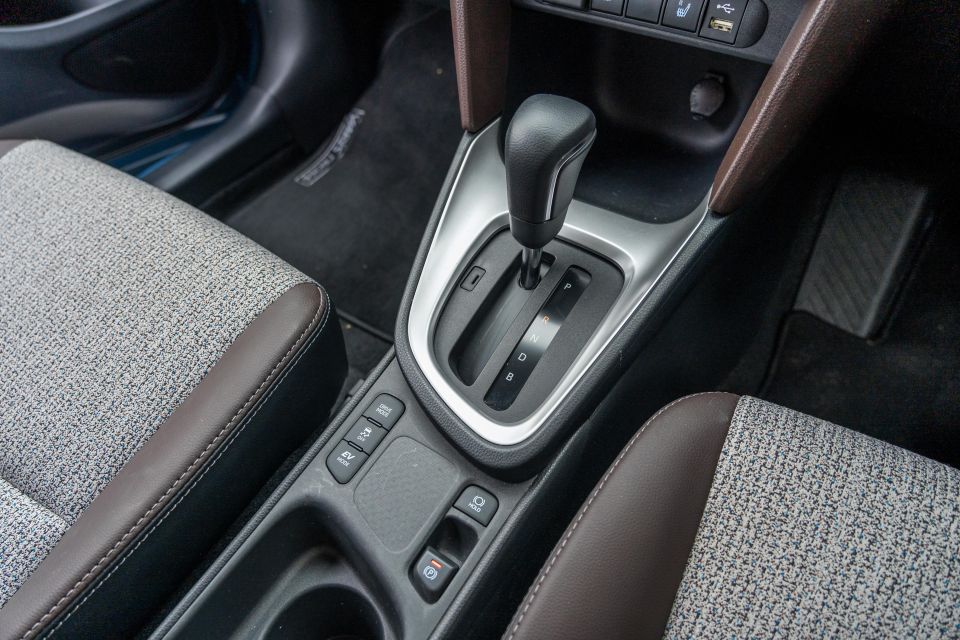
Fuel use for the front-drive model is quoted at an impressive 3.8L/100km on the combined cycle, with emissions rated at just 86g/km of CO2 (combined).
During our week with the Yaris Cross, we managed a still-impressive 4.4L/100km as indicated via the trip computer over a mix of urban and highway driving.
The hybrid will happily run on regular 91 RON unleaded, and the fuel tank measures a teeny-tiny 36L.
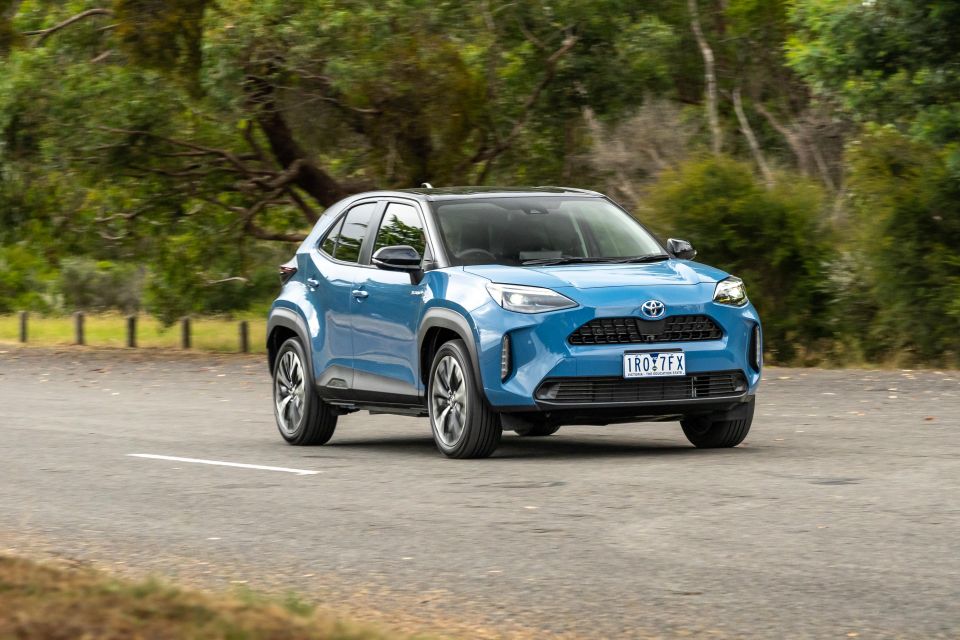
I wasn’t expecting the Yaris Cross to be too different from the Yaris ZR Hybrid I recently reviewed, but there are some noticeable differences that left me thinking the SUV version might be the better choice.
While the engine and platform are largely the same, as is the interior, the Yaris Cross feels a bit larger and more planted on the road thanks to its larger 18-inch wheels and wider 215/50 R18 tyres – the Yaris ZR hatchback wears skinny 185/55 R16 rubber.
That translates to a more confident feel particularly at higher speeds, and more contact with the road gives the impression of better grip. Sure, this is no sports car, but in poor weather conditions or when turning at high speeds you’ll notice the difference.
In terms of performance, the Yaris Cross is about 100kg heavier than the Yaris hatch in front-drive hybrid guise (1215kg tare), and as a result feels a touch slower and heftier than its city car equivalent.
The 1.5-litre hybrid drivetrain offers excellent real-world fuel economy, though under hard acceleration the three-cylinder petrol engine can be loud, gruff and unrefined.
It’s also not particularly quick in general, not helped by the added weight of the Yaris Cross’ SUV body.
Being a city-focused crossover, the powertrain can perform adequately for its intended purpose, but getting up to freeway speeds takes a bit more effort from the engine(s) and overtaking requires some planning and thought.
Once you’re cruising, though, it’s actually really good. There’s not much engine noise entering the cabin at 100km/h, and occasionally you’ll even see the EV Mode light come on as the petrol engine shuts off under low load on flat surfaces or downhill.
Wind and road noise is fairly well suppressed for a vehicle of this type, but tyre roar over coarse chip roads is noticeable.
Despite the bigger rims and lower-profile tyres compared to lower models, the Toyota Yaris Cross is pretty comfortable to live with day-to-day and rarely crashes over the various lumps and bumps inner-city and suburban life will throw at you.

At times the rebound at the rear will be a tad sharp, but otherwise it’s perfectly happy over speed humps, potholes and road joins.
The TNGA underpinnings also means there’s a feel-good factor to the way the Toyota Yaris Cross handles.
Like the hatchback on which it’s based, there’s a natural, direct feeling through the steering and the vehicle’s compact dimensions and keen chassis make for a fun steer. It may not have a lot of power, but the Yaris Cross is a relatively engaging drive whether you’re navigating tight city streets or a twisty B-road.
The compact dimensions and lighter steering also make parking an absolute breeze, aided further by the Urban trim level’s surround cameras.
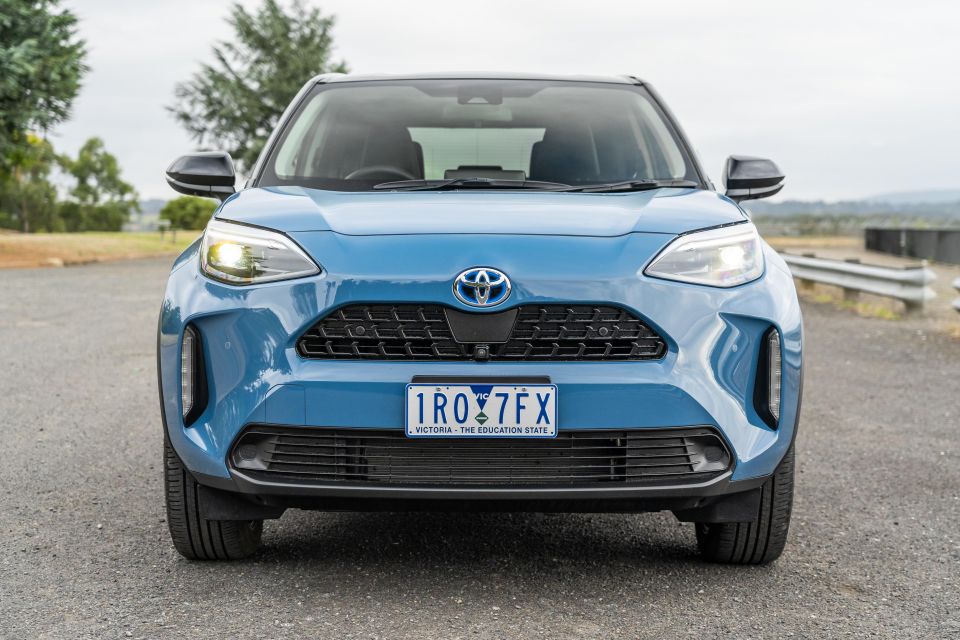
As for the Yaris Cross’ wider suite of active safety and assistance systems, Toyota has done a great job at calibrating features such as the adaptive cruise control and lane assist/centring functions given previous iterations have been too intrusive or overzealous.
The radar-guided cruise function did a good job at maintaining reasonable distances from leading cars and holding the set speed, while the lane-keep assist and lane centring functions aren’t violently tugging the wheel out of your hands.
Blind-spot monitoring and rear cross-traffic alert are handy features to have regardless of the class of car you have these days, and proved helpful when making tight gaps in traffic or reversing out of parking spots with poor visibility.
Overall, I was pleasantly surprised with the Yaris Cross on the road, as most compact and sub-compact SUVs tend to be inferior drives to their passenger car counterparts. I believe it’s the opposite case here.
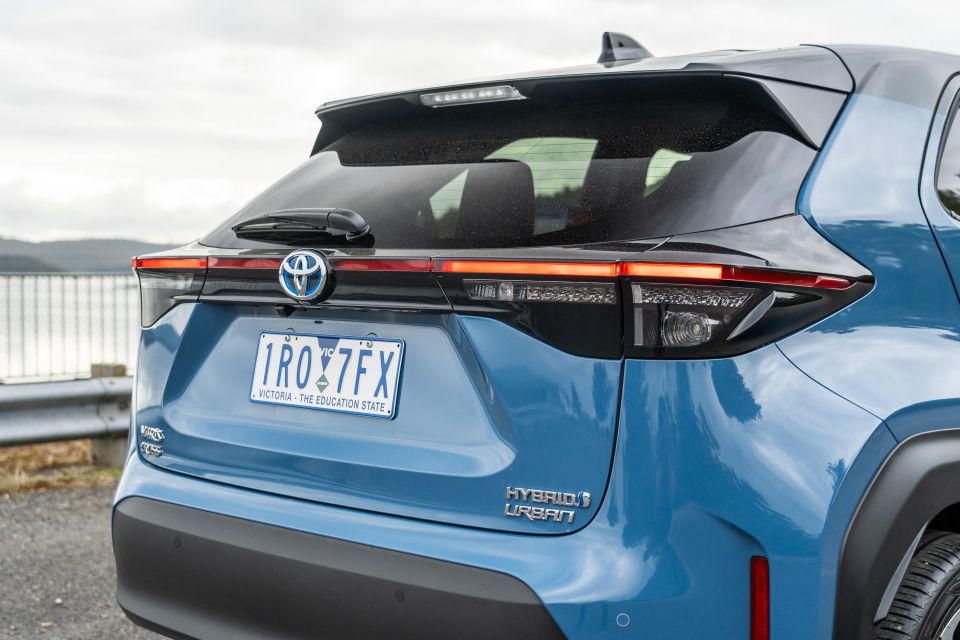
The Yaris Cross is covered by Toyota’s five-year, unlimited-kilometre warranty.
Servicing is required every 12 months or 15,000 kilometres, whichever comes first.
There’s four years of capped-price servicing on offer, with each visit costing $205 over 48 months or 60,000km – making the Yaris Cross one of, if not the cheapest vehicle to maintain in its class in terms of scheduled maintenance.
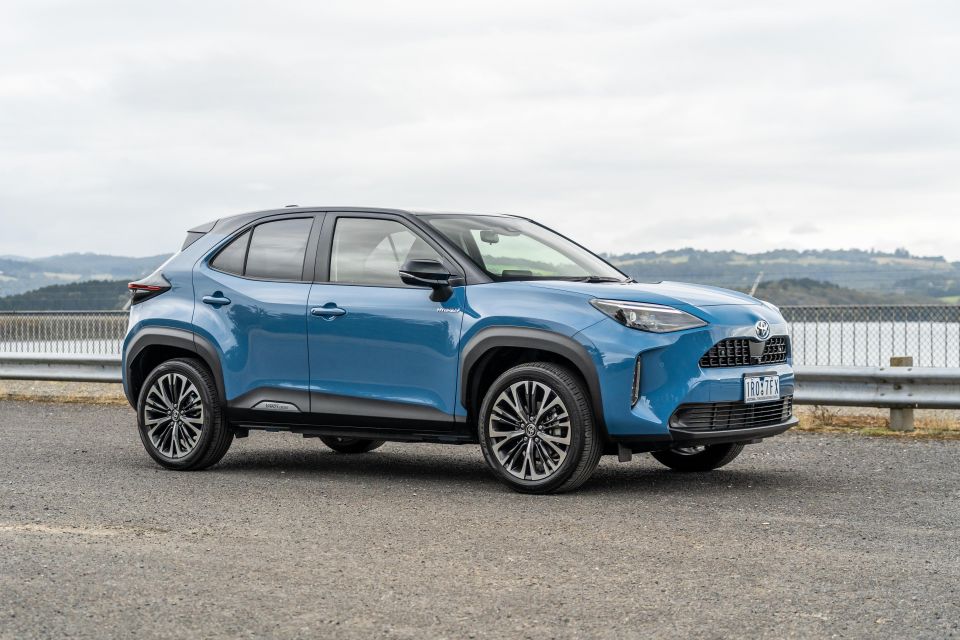
Where the regular Yaris seems overpriced relative to its competition, the Yaris Cross embodies the strengths of its hatchback sibling in a more compelling package.
In flagship trim with the front-drive hybrid drivetrain option, the Yaris Cross is competitively priced and specified compared to its direct rivals, and the petrol-electric running gear brings huge economy benefits.
What it lacks in punch, the Yaris Cross makes up for in visual flair, class-leading fuel economy and emissions, as well as an easy, comfortable everyday drive experience.
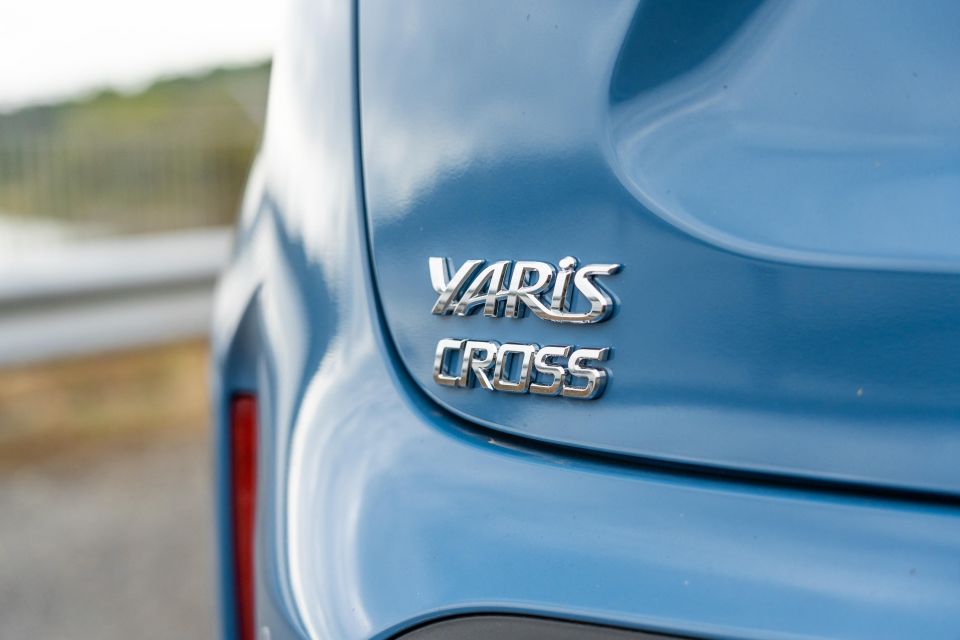
Click the images for the full gallery
MORE: Toyota Yaris Cross news and reviews MORE: Everything Toyota
Where expert car reviews meet expert car buying – CarExpert gives you trusted advice, personalised service and real savings on your next new car.
James is an automotive journalist based in Melbourne, Australia. Before joining CarExpert.com.au in 2020, James has worked at leading auto media outlets including Carsales and CarAdvice, as well as at Pulse agency for Ford Australia's communications team. In 2019 James made Mumbrella's 'Top 20 most prolific web authors in Australia' list after publishing 1,360 articles between March 1, 2018 and February 28, 2019 for CarAdvice. James is also an Ambassador for Drive Against Depression – an Australian charity whose mission is to support mental wellness through the freedom of driving and a shared love of cars.


Andrew Maclean
1 Month Ago


Josh Nevett
1 Month Ago


Matt Campbell
25 Days Ago
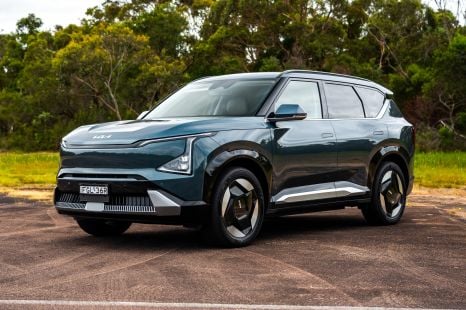

James Wong
18 Days Ago


CarExpert.com.au
11 Days Ago
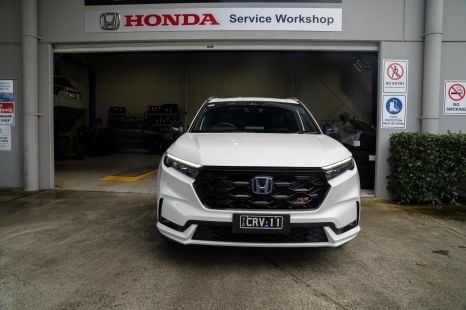

CarExpert.com.au
9 Days Ago